
(Photo: Below the roof on the first pitch of Feast of Fools (5.10b).)
What a difference two weeks can make.
During Labor Day weekend I felt a little rusty and out of shape, trudging up climbs in a sticky summer stupor.
But this past Sunday was like another world. The weather was absolutely perfect and I felt almost like myself again.
I drove up early from NYC and picked Gail up at her house in Gardiner. We didn't have much of a plan. In the time since Labor Day I'd made it to the gym a few times. I felt okay, certainly better than when I got back from summer vacation, but I couldn't say I was back to climbing my best. Nevertheless the night before we met up I suggested to Gail that I might be game to check out one of the Gunks 5.10's on my list, like Feast of Fools (5.10b) or even 10,000 Restless Virgins (5.10d).
It's easy to be brave in an email.
When I got to Gail's house the temperatures were still in the 40's (!) but by the time we got to the cliff and hiked up the Stairmaster it had warmed up. I was comfortable all day in just a tee shirt with no jacket. On the carriage road we could see lots of people streaming into the Trapps, but when we got to the Arrow wall we found ourselves surprisingly alone.
What a fine situation to be in: we had glorious clear weather and some of the best moderate climbs in existence right in front of us, all of them empty. We decided to warm up with a few of routes on this wall. Gail led the first pitch of Arrow (this first pitch is 5.6) and then I led our next three pitches, knocking off the upper pitches of Arrow (5.8), Annie Oh! (5.8) and Three Doves (5.8+).
The combination of cool temperatures and the white, marble-like rock of the Arrow wall was magical. Chalk was almost unnecessary.
Arrow is always a pleasure, and the bolts make it a totally mellow experience.
I was curious about Annie Oh! because I hadn't been on the climb since the scary loose block in the middle of the pitch fell out last November. I can't say its absence has changed the climb much. As I climbed the pitch I wasn't even sure where the block had fallen out from. One somewhat scary feature remains on the pitch, a flake/overlap that seems to be attached but which rings quite hollow. There is an old fixed Alien underneath it. You need to place pro underneath and climb atop this feature to do the route; if it ever comes off it could be ugly. Despite this one concern
I love the second pitch of Annie Oh!; it has so many great moves on it, all the way to the very last one up a seemingly blank notch.
The top pitch of Three Doves is also fantastic. It is a step up in difficulty from Annie Oh! and it too has a strong hold on my affections. I love the delicate face moves to the roof and then the traverse right is exciting. I thought about moving left instead of right to finish through the 5.9+ ceiling of Hawkeye, just for a change, but it was only my second time on Three Doves and I was enjoying it so much I decided to carry on and finish it the regular way.
By the time we descended from Three Doves the wall had become very crowded. It seemed that every route suddenly had a party on it. (There was a leader on Annie Oh! climbing in bare feet!) We decided to return to the ground to see if Feast of Fools was available. I tried not to get my hopes up. I'd been looking to hop on Feast of Fools all year but because it has a bolted anchor atop its first pitch it always seems to have a huge group of top ropers hogging it. I assumed today would be no different, but who knew, I thought, we might get lucky.
It turned out no one was climbing Feast of Fools but there was a man at its base belaying his partner up the first pitch of Proctoscope (5.9+), around the corner. He said he was planning to lead Feast in a minute when his partner finished Proctoscope, but that if I wanted it now I could have it. His politeness overwhelmed me, so much so that I felt guilty about taking advantage.
Gail suggested I might like Proctoscope. (She'd been on it before.) I'd been curious about it, but it was not on my immediate tick list. I thought I had read that it was hard to protect. But when I looked up I could see that the man we were speaking with had several placements through the steep crux face. He had sewn it up. It looked quite safe. The climb would shortly be available. His partner appeared poised to finish up pretty soon.
I decided to give Proctoscope a try.
The first pitch is technical and challenging. The early going is easy, up a six-inch off-width that you can't protect without a Big Bro or some really big cams. But there are jugs in the off-width, so it really isn't a big deal. Once you get your first gear in, maybe twenty feet up, the pitch is very well protected from that point on. After the off-width you step left to a similarly easy chimney which leads to the business of the pitch, the steep orange face beneath a ceiling.
I really liked the steep orange face, and I did a good job on it.... until I didn't.
As of this writing there are two fixed pieces on the face, a piton right at the start, and later a fixed wire up near the ceiling, at the crux move. I clipped the piton and made the first thin, easy-does-it move upward. Then I plugged a cam in an obvious side-pull hold, being careful not to make the hold impossible to use. So far, so good. Gently stepping up again, I was already level with the fixed wire. It appeared I was one move away from a good hold, a jug up and left. If I could get up to that hold I might be done with the hard stuff. I'd just have to do a few easy moves up and left, skirting the ceiling and reaching the bolted anchor.
Only one thing stood between me and the onsight. The handholds were terrible. These are the "small, rounded holds" mentioned in Dick Williams' guidebook description for Proctoscope. I had a great foothold but I was barely holding on to a shallow crimp with my right hand. My left hand was on a sloper I considered basically useless. I was sure I'd fall if I released my right hand, so I carefully reached down with my left hand, got a draw and clipped the fixed nut. Then, feeling very tense and still gripping like mad with the right hand, I slowly clipped the rope to the draw.
Whew! Now I needed to move. I saw no good footholds, but I thought maybe I could step on this one indentation. I started to step up to grab the good shelf, but my toe slipped and whoosh, just like that, I was off. I had taken a fall on the fixed nut.
One move away from the jug. I was angry that I'd blown it. In my anger I rushed right back up there, got out of sequence and immediately fell again.
I recharged and tried to be more patient. And the third time it worked out. I didn't over-grip with the right hand, and I searched around to find a slightly better hold for the left. Once I found one I was able to bump up to the jug, and the difficulties were over.
This is a high quality pitch. I regret screwing it up. The fixed wire really helps. Placing your own gear there at the crux would increase the difficulty. It would be very tempting to just run it out to the next move.We were planning on doing the 5.8 pitch two of Proctoscope so I stayed at the bolts and brought Gail up. When I arrived the man we'd met earlier had finished with pitch one of Feast of Fools and had his rope up on the chains for the other people in his party. And while I was standing there another pair, two young women, rapped in from a tree on the GT ledge. They were hoping to set up their rope to top rope Feast after the other party finished. When Gail arrived we had four people and three ropes on this one anchor. it was kind of a mess, but it was just another Sunday in the Gunks.
We waited while the other pair at the anchor sorted out their plans and then I led pitch two. I liked it. It is worth doing at least once. It features a fun roof problem, directly above the belay. The roof is well-protected and there is another nice move to get established above the roof. After that it has easy and not very interesting climbing going left to avoid the larger ceiling and head up to the GT Ledge.
We took a quick look at the third pitch of Proctoscope, which diagonals up the huge arching corner just left of the upper pitch of Nurse's Aid. This 5.8 pitch trends left until it reaches the top of cliff right next to Arrow. It is not recommended by the guidebook. It looked not-so-awful to us, but Gail's husband Mitch came out to meet us as we finished pitch two-- he has just begun climbing again after a lengthy battle with a wrist injury-- so we rapped down from the Arrow bolts to meet him. The Arrow wall was still packed with people, which worked out to our benefit. Janette Pazer of the famous Family Climbing group was there with some friends. They had the first pitch of Annie Oh! set up and they kindly allowed Mitch and Gail to take a run up their rope.
While Mitch and Gail were over on Annie Oh!, I staked out the base of Feast of Fools. The young women with whom we'd shared the bolted belay station were almost done with the route. By the time they cleared out, Mitch was free for me. I was all set to go. Mitch belayed me for my onsight attempt on Feast of Fools.

(Photo: Confronting the starting moves on Feast of Fools (5.10b).)
I'd been excited about this pitch for a long time. It looks intimidating, with a big roof providing the first crux and a second crux at a small overhang and steep corner above. I'd made a point of never top-roping it, hoping to "save" it for the onsight. And now the time at last had come. But as I started up I found the first few moves to be surprisingly mysterious. The sun was soon to go behind the cliff, but at this moment it was beating down on me. I felt hot, for the first time all day. I was nervous. I wondered, "do I really want to do this?"
The answer: I did, in the worst way.
After a minute I settled down and made a move up, then soon found myself beneath the first roof, which is really a big pancake flake stuck in the cliff. I had thought this wouldn't be so bad, since you don't really pull the roof but rather go around it, escaping to the right.
But the holds underneath are tiny crimps and it felt very committing to reach out to the big flake. I placed an Alien in the corner and cowered there for a bit. Then I made a reach to the right (see the photo at the top of this post), because I thought I needed to move over there before grabbing the flake. And it was strenuous to hang out there. The holds were tiny. Placing another piece there would be difficult.
I retreated back to the corner, and asked Mitch if I was going the right way. Did I need to go out there to the right?
"I think you do," he replied. "And I think when you go for it and just grab the big flake it will all make sense and you'll feel fine."
But it didn't seem like it would feel fine. It felt awkward and scary. I moved out again, placing another Alien. Then I retreated again.
Then I finally went for it and it turned out Mitch was right. As soon as I reached out and grabbed the pancake flake everything was fine. Moving right was easy, and then I was over the roof in no time. Crux number one was done with.
The second crux of Feast of Fools is famous for being protected by two old pins. As I stood at the rest stance beneath the pins I could see that it appeared one of them had been replaced. It looked brand new. I was thrilled.
But when I tried to move up and clip the pins I found it very difficult. The stance there is very steep and the holds are poor.

(Photo: At the second crux on Feast of Fools, at the pins.)
The first time I went up to the pins, I couldn't find the draws on my harness. So I climbed back down and moved my stuff around. The second time I went up, it was all I could do to hang a draw on the pin. I was afraid I'd fall if I tried to attach the draw to the rope. So I retreated to the stance again. After resting a bit more I went back up and clipped the rope. Then I retreated once again, and repeated the whole process with the second pin. I climbed up and down at least four or five times.
I am grateful that Mitch and Gail are patient people. I really made this pitch into a lengthy process. But I didn't want to blow it. I was determined.
It was finally time to fire through the moves.
When I went for it I found out I had already done the hardest bit, four or five times. Hanging on at the pins is the crux! I had the moves to the pins all worked out now, and once I reached up above the pins, there were no problems. The holds improved and in just a few moves the pitch was over. It hadn't been all that pretty but I had my onsight of Feast of Fools. It felt good.
It is a really good pitch, with two nice cruxes. It seems to me the hardest parts are not the cruxes themselves, but rather placing protection for the cruxes. And at both cruxes you can hang in there, get the gear you need, and then take a step back to rest before moving on. In this way Feast of Fools is easier than Proctoscope. There was no way I was down-climbing to rest after clipping the fixed wire at the crux on Proctoscope. I had to keep climbing or take a fall.

(Photo: Gail making it look easy while following pitch one of Feast of Fools, at the pancake flake.)
It would have been nice to do pitch two of Feast of Fools-- it is supposed to be a really good 5.10a pitch-- but we'll have to come back for that. Mitch was heading out, and the anchor above pitch one was still in heavy use from multiple parties. We didn't really want to be stuck there in a traffic jam again.
Instead we went to do No Glow (5.9). Gail wanted a nice casual lead and the first pitch is 5.4. I was happy to do the second pitch, as it is a pretty mellow 5.9 that I've led before.

(Photo: Gail in the unprotected early going of No Glow.)
I enjoyed No Glow, as usual, but just below the top I got scared when I placed my hand on a feature, not realizing it was actually a detached block. This block is just two moves from the top, a little bit to the right as you come up. It is about three feet wide, and is Texas-shaped. When I barely touched this block it shifted. I really thought it might come off. It scared the crap out of me.

(Photo: Yes, that is the block. Photo stolen from Gunks.com.)
I was also a little bit more unnerved than usual by the sickle-shaped flake/block that sits above and to the right of the crux move. Everybody yards on this block to get over the crux. But it is just sitting on a tiny shelf. When we rapped down No Glow last Sunday I took a closer look at this sickle-shaped flake/block and I realized for the first time that only its left edge is sitting on the shelf. The right side is actually quite a bit wider than the shelf on which it sits and it's just hanging there in space.
I don't want to overreact. There are many loose blocks all over the place, and these particular features on No Glow have existed there for many years. No one has died yet. But twice this year in Yosemite climbers have died after loose blocks were pulled off of popular trade routes. Just because it hasn't happened yet doesn't mean we should ignore obvious risks. I think these two features on No Glow are ticking time bombs. I'm done with that route.
If you climb it, please don't touch that block near the top. (It is easily avoided.) I think just a little shove would send it right down the cliff.
Anyway, nothing bad happened so it didn't put too much of a damper on our wonderful day. I left the Gunks feeling thrilled to have gotten a 5.10 onsight for once. It was a great start to autumn. I hope this fall will be a real sending season.




















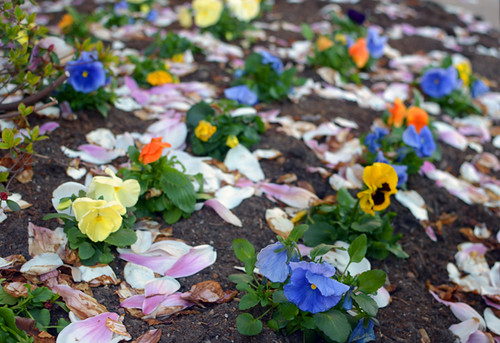
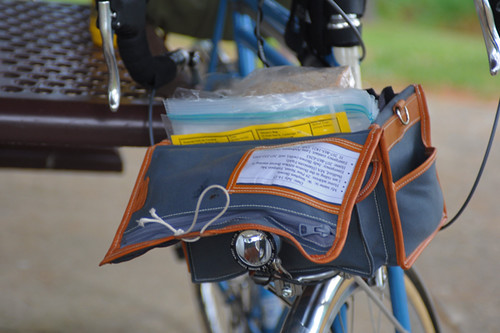
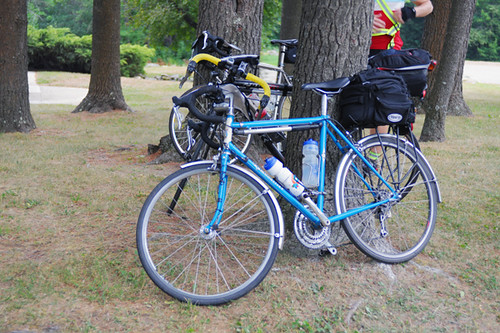

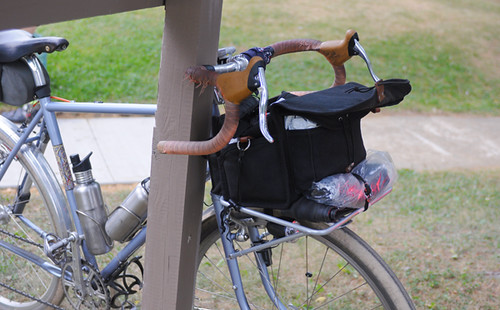
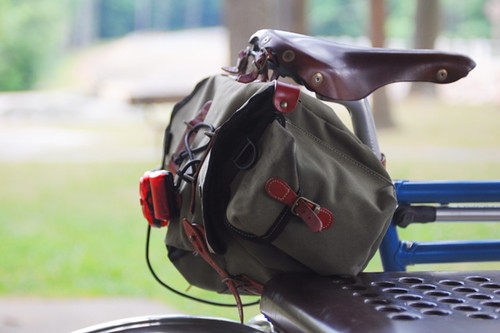
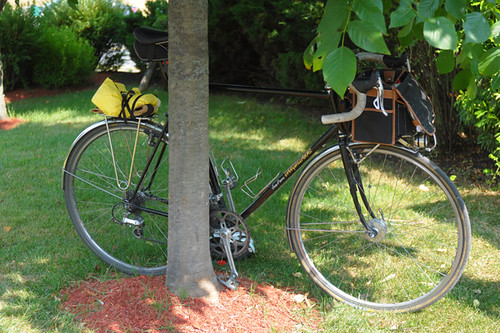
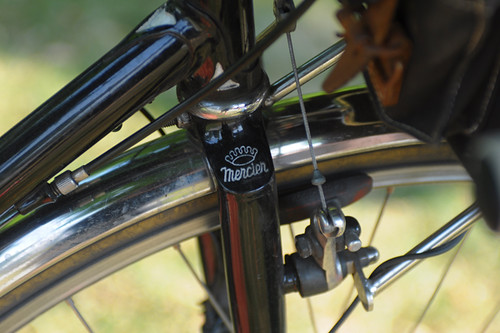
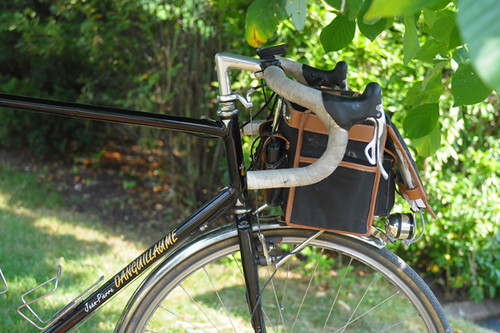
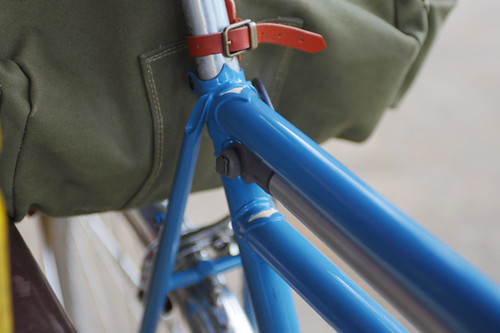




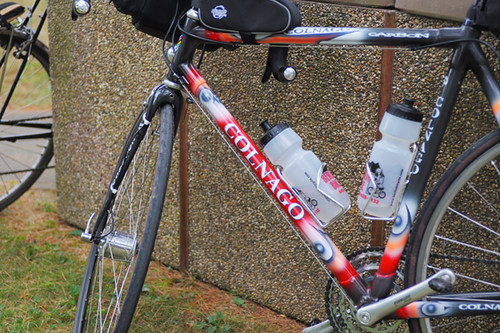









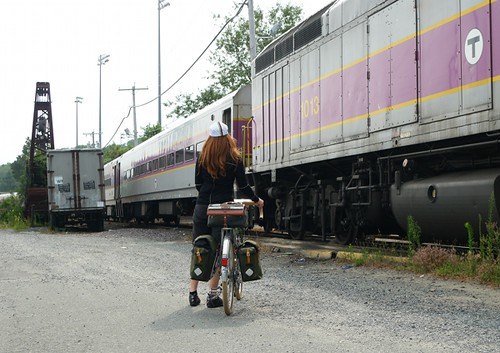 As you may have noticed, we are staying on the coast for a little while - our annual working vacation. This is something we've been doing at the end of every summer for the past six years. When we lived further North, we used to go to a place in Maine, and after moving to Boston we began staying on Cape Cod. I've been writing about that for the past two summers, and it's funny how over time our trips became increasingly bicycle-oriented. Two years agowe went by car as usual, but for the first time took bikes and cycled around a bit during our stay. Last summer we arrived by car again, but got around entirely by bicycle once there and attempted some high mileage day-trips. This summer we no longer have a car and really did not want to rent one just for the trip. So after discovering that Cape Ann was accessible by commuter rail, we decided to come here instead and do the whole trip on bikes. Another reason for choosing Cape Ann, is that it is a popular starting point for long rides up the coast of Northern New England. There are no decent routes north directly out of Boston, and what cyclists often do is take the commuter rail up here before proceeding north. So that was the plan: To arrive on our bicycles, to get around by bike, and to cycle up the coast as far and as often as possible in the course of our stay.
As you may have noticed, we are staying on the coast for a little while - our annual working vacation. This is something we've been doing at the end of every summer for the past six years. When we lived further North, we used to go to a place in Maine, and after moving to Boston we began staying on Cape Cod. I've been writing about that for the past two summers, and it's funny how over time our trips became increasingly bicycle-oriented. Two years agowe went by car as usual, but for the first time took bikes and cycled around a bit during our stay. Last summer we arrived by car again, but got around entirely by bicycle once there and attempted some high mileage day-trips. This summer we no longer have a car and really did not want to rent one just for the trip. So after discovering that Cape Ann was accessible by commuter rail, we decided to come here instead and do the whole trip on bikes. Another reason for choosing Cape Ann, is that it is a popular starting point for long rides up the coast of Northern New England. There are no decent routes north directly out of Boston, and what cyclists often do is take the commuter rail up here before proceeding north. So that was the plan: To arrive on our bicycles, to get around by bike, and to cycle up the coast as far and as often as possible in the course of our stay.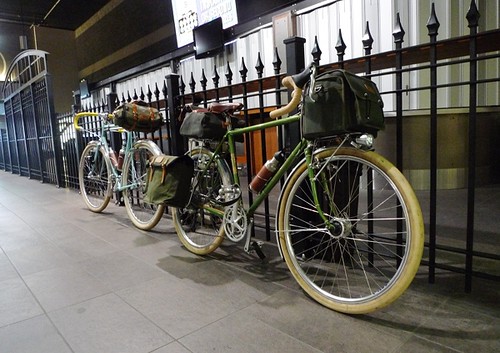 Our main challenge was figuring out how to transport our belongings. This is not a bicycle-specific trip, so we needed more than a change of cycling clothing and rain gear. We are living here for two weeks and doing all the same things we do at home - including work-related stuff. We needed our regular clothing and footwear, personal hygiene products, bedding, towels, laptops, a variety of electronic devises, some necessary books and documents, and our camera equipment - in addition to the cycling clothing, tool kits and raingear. And all of that we fit into the luggage you see here.
Our main challenge was figuring out how to transport our belongings. This is not a bicycle-specific trip, so we needed more than a change of cycling clothing and rain gear. We are living here for two weeks and doing all the same things we do at home - including work-related stuff. We needed our regular clothing and footwear, personal hygiene products, bedding, towels, laptops, a variety of electronic devises, some necessary books and documents, and our camera equipment - in addition to the cycling clothing, tool kits and raingear. And all of that we fit into the luggage you see here. For a number of logistical reasons, we decided the most practical course of action would be to turn one person into the pack mule - and since I already had a front rack and a large handlebar bag on my bike, it made sense that this would be me. I had planned to eventually get a touring-specific rear rack for my Rivendell anyway, and so that is what I did. Between the two of us, we packed a total of five bags for the trip - four on my bike and one on the Co-Habitant's.
For a number of logistical reasons, we decided the most practical course of action would be to turn one person into the pack mule - and since I already had a front rack and a large handlebar bag on my bike, it made sense that this would be me. I had planned to eventually get a touring-specific rear rack for my Rivendell anyway, and so that is what I did. Between the two of us, we packed a total of five bags for the trip - four on my bike and one on the Co-Habitant's.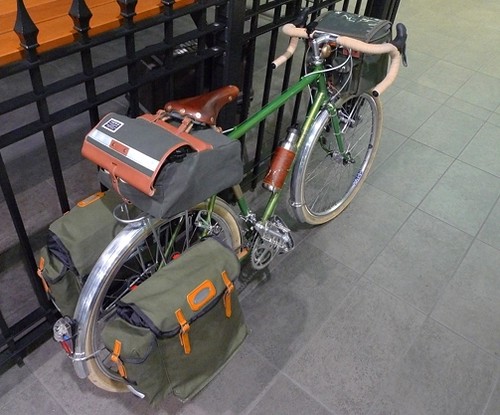 The rear rack on my bike is a Nitto Campee with removable lowrider panels, to which we attached a set of Carradice panniers, while using the rack's platform to support a Sackville SaddleSack. These bags plus the Carradicesaddlebag on the Co-Habitant's Surly contained our clothing, bedding and laptops. My Ostrich handlebar bag contained camera equipment, electronics and various other miscellaneous items. Everything was packed very tightly, and I estimate that my bicycle weighed around 100 lb when all was said and done.
The rear rack on my bike is a Nitto Campee with removable lowrider panels, to which we attached a set of Carradice panniers, while using the rack's platform to support a Sackville SaddleSack. These bags plus the Carradicesaddlebag on the Co-Habitant's Surly contained our clothing, bedding and laptops. My Ostrich handlebar bag contained camera equipment, electronics and various other miscellaneous items. Everything was packed very tightly, and I estimate that my bicycle weighed around 100 lb when all was said and done.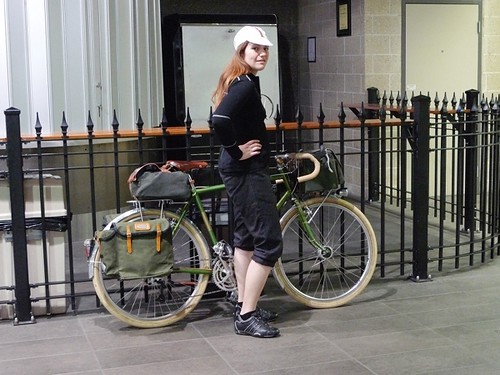 The ride to the train station from our house is 4 miles through some of the busiest parts of the city. I have never ridden with my bike loaded up like this before, and the prospect of trying it for the first time in Boston traffic was nerve-wrecking. Overall, the bicycle handled fine. Once it got going, I could not feel the weight at all, and the heavy handlebar bag did not affect steering. But at very slow speeds - especially when starting and stopping - there was a fishtailing effect in the rear that took some getting used to. Also, with so much weight on the bike, the brakes were less effective than usual, which I had to keep in mind when stopping on a downhill. The frame itself had an interesting feel to it - as if it was "yielding" to the weight (mildly flexing?). The resulting ride quality was in some ways nicer than with the bicycle unloaded. Having survived this ride in traffic, loaded touring on the open road does not seem in the least daunting. Going slower than usual is, of course, a given - but the reduction in speed was not as drastic as I thought it might be. Even cycling uphill (which I got to experience once we arrived to Cape Ann and rode from the train station to the place we are staying!) was not as difficult as I expected. Thanks to a helpful reader after my description of our previous commuter rail experience, we were able to board the elusive bike train, which made the trip more pleasant still.
The ride to the train station from our house is 4 miles through some of the busiest parts of the city. I have never ridden with my bike loaded up like this before, and the prospect of trying it for the first time in Boston traffic was nerve-wrecking. Overall, the bicycle handled fine. Once it got going, I could not feel the weight at all, and the heavy handlebar bag did not affect steering. But at very slow speeds - especially when starting and stopping - there was a fishtailing effect in the rear that took some getting used to. Also, with so much weight on the bike, the brakes were less effective than usual, which I had to keep in mind when stopping on a downhill. The frame itself had an interesting feel to it - as if it was "yielding" to the weight (mildly flexing?). The resulting ride quality was in some ways nicer than with the bicycle unloaded. Having survived this ride in traffic, loaded touring on the open road does not seem in the least daunting. Going slower than usual is, of course, a given - but the reduction in speed was not as drastic as I thought it might be. Even cycling uphill (which I got to experience once we arrived to Cape Ann and rode from the train station to the place we are staying!) was not as difficult as I expected. Thanks to a helpful reader after my description of our previous commuter rail experience, we were able to board the elusive bike train, which made the trip more pleasant still. 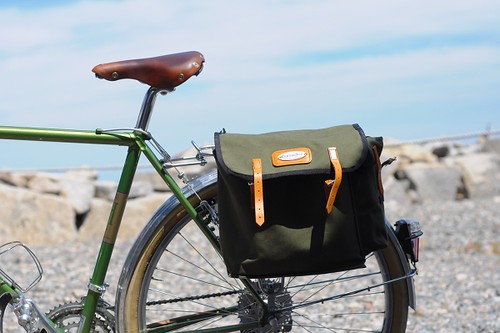 Once we arrived and settled in, we removed the lowrider panels from the rear rack, transforming my bike from a full-on pack-mule into a lighter ridethat could still carry food and equipment when necessary. I will write more about this particular rear rack in a separate post; it is pretty neat and versatile.
Once we arrived and settled in, we removed the lowrider panels from the rear rack, transforming my bike from a full-on pack-mule into a lighter ridethat could still carry food and equipment when necessary. I will write more about this particular rear rack in a separate post; it is pretty neat and versatile.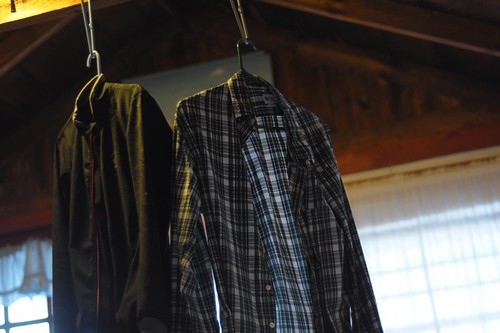 The place where we are staying is somewhere between a cabin and a shack on the architectural spectrum and is the size of a small garage. It is situated on a rocky cliff overlooking the ocean, and there is a beach down the road. Despite the stormy weather, we love being here - just the two of us and our bikes. Yesterday the sun finally came out and we did a 50 mile "warm-up" ride, hoping for more soon. And it feels great that we were able to drag all of our stuff up here without needing a car. It was important to us that this did not feel like a compromise compared to the previous times we've gone away, and it most definitely does not. We were able to fit everything we need into our bicycle bags, and not having to deal with a car here feels extremely relaxing. I highly recommend giving traveling by bicycle a try!
The place where we are staying is somewhere between a cabin and a shack on the architectural spectrum and is the size of a small garage. It is situated on a rocky cliff overlooking the ocean, and there is a beach down the road. Despite the stormy weather, we love being here - just the two of us and our bikes. Yesterday the sun finally came out and we did a 50 mile "warm-up" ride, hoping for more soon. And it feels great that we were able to drag all of our stuff up here without needing a car. It was important to us that this did not feel like a compromise compared to the previous times we've gone away, and it most definitely does not. We were able to fit everything we need into our bicycle bags, and not having to deal with a car here feels extremely relaxing. I highly recommend giving traveling by bicycle a try!